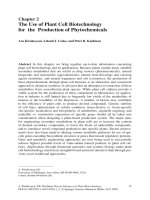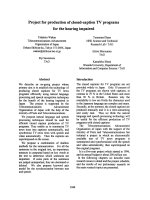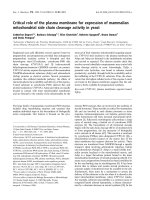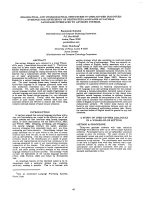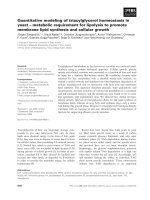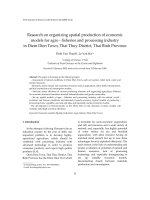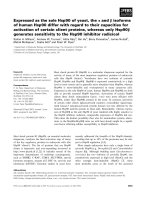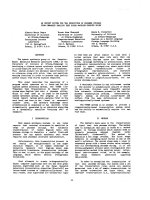Yeast systems biotechnology for production of value added biochemicals
Bạn đang xem bản rút gọn của tài liệu. Xem và tải ngay bản đầy đủ của tài liệu tại đây (2.81 MB, 163 trang )
YEAST SYSTEMS BIOTECHNOLOGY FOR PRODUCTION
OF VALUE-ADDED BIOCHEMICALS
CHUNG KAI SHENG, BEVAN
(B. Eng. (Hons.), NUS)
A THESIS SUBMITTED
FOR THE DEGREE OF DOCTOR OF PHILOSOPHY
NUS Graduate School for Integrative Sciences and Engineering
NATIONAL UNIVERSITY OF SINGAPORE
2012
i
Declaration
I hereby declare that this thesis is my original work and it has been written by me in
its entirety. I have duly acknowledged all the sources of information which have been
used in the thesis.
This thesis has also not been submitted for any degree in any university previously.
Chung Kai Sheng, Bevan
12 November 2012
ii
Acknowledgements
It gives me great pleasure to express my heartfelt thanks to people who have,
in one way or another, contributed to the successful completion of this thesis. First
and foremost, I want to thank my Lord, Jesus Christ, whose super-abounding grace
has supplied me with all that I need to accomplish my tasks in life.
I am grateful to my supervisor Asst. Prof. Lee Dong-Yup who has played an
instrumental role in imparting invaluable research skills. Interactions with the Thesis
Advisory Committee members, Prof. Karimi, I.A. and Asst. Prof. Matthew Chang,
have also helped to hone my analytical skills.
I wish to acknowledge the scientists in the Korea Research Institute of
Bioscience & Biotechnology (KRIBB), especially Dr. Ahn Jung Oh, Dr. Choi Eui-
Sung and Dr. Lee Hong-Weon, for their valuable advice and for being such hospitable
hosts during my research stint in Korea. The colleagues in the Biotechnology Process
Engineering Center (BPEC) of KRIBB have also been very accommodating and
helpful.
I am also thankful for the company of colleagues and fellow Ph.D. students
from the Bioinformatics group of Bioprocessing Technology Institute (BTI),
A*STAR, and the Department of Chemical and Biomolecular Engineering, NUS, who
have contributed to my growth as a researcher through intellectually stimulating
discussions and the sharing of useful insights.
Finally, I want to thank my loved ones: my parents, Mr. Chung Eng Huat and
Ms. Lum Siew Yoke, for their care and support, and Ms. Pan Yihui Summer for her
love and encouragement during the course of my Ph.D.
iii
Table of Contents
Summary vi
List of Tables viii
List of Figures x
List of Symbols xiii
Chapter 1. Introduction 1
1.1. Background of yeasts 1
1.2. The Pichia pastoris expression system 2
1.3. Scope of thesis 3
1.4. Organization of thesis 4
Chapter 2. Overview of systems biotechnology 7
2.1. The advent of systems biology 7
2.2. Application of systems biology to biotechnology 9
2.3. In silico modeling of biological systems 10
2.4. Constraints-based flux analysis 13
2.4.1.Thebasicconstraints‐basedfluxanalysisframework 14
2.4.2.Exploringmetaboliccapabilitiesusingconstraints‐basedfluxanalysis 18
2.4.3.Strainimprovementusingconstraints‐basedfluxanalysis 19
2.5. Genome-scale metabolic model (GSMM) 20
2.5.1.GSMMreconstruction 20
2.5.2.GSMMvalidation 22
Chapter 3. Pichia pastoris genome-scale metabolic model reconstruction 24
3.1. Methylotrophic yeast Pichia pastoris 24
3.2. Reconstruction of P. pastoris genome-scale metabolic model 25
3.3. Manual curation and gap-filling 27
3.4. GSMM biomass composition 29
3.4.1.Overallcellularcomposition 30
3.4.2.Aminoacidcomposition 30
3.4.3.Carbohydratescomposition 31
3.4.4.DNAcomposition 32
3.4.5.RNAcomposition 32
3.4.6.Lipidcomposition 33
iv
3.4.7.GrowthassociatedATPrequirement 34
3.4.8.Otheressentialbiomasscomponents 35
3.4.9.Biomasssynthesisreaction 36
3.5. Uniqueness of P. pastoris metabolism 37
3.6. P. pastoris chemostat culture 41
3.7. GSMM validation 42
3.7.1.Non‐growthassociatedATPmaintenancerequirement 42
3.7.2.Validationwithchemostatexperimentaldata 43
3.7.3.Validationwithomicsdata 45
3.7.4.QualityoftheiPP668model 49
3.8. GSMM reconstruction in systems biotechnology 50
Chapter 4. Flux-sum analysis 51
4.1. Reaction-centric versus metabolite-centric perspectives 51
4.2. Flux-sum analysis 51
4.3. Flux-sum perturbation 53
4.3.1.Linearizationofflux‐sum 53
4.3.2.Flux‐summaximization 54
4.3.3.Attenuationandintensificationofflux‐sum 55
4.4. Case study: Metabolite flux-sums of E. coli 56
4.4.1.Basalmetaboliteflux‐sums 57
4.4.2.Flux‐summaxima 59
4.4.3.Flux‐sumattenuationanalysis 61
4.4.4.Flux‐sumintensificationanalysis 64
4.4.5.Flux‐sumbasedmetaboliteclassification 67
4.5. Flux-sum analysis for enhancing succinate production 68
4.5.1.Flux‐sumattenuationtargetforimprovedsuccinateproduction 70
4.5.2.Flux‐sumintensificationtargetsforimprovedsuccinateproduction 74
4.5.3.Flux‐sumperturbationformetabolicengineering 75
Chapter 5. P. pastoris GSMM analysis 76
5.1. P. pastoris GSMM for recombinant protein production 76
5.2. Protein synthesis in P. pastoris GSMM 77
5.3. Carbon source analysis for recombinant protein production 80
v
5.4. P. pastoris for whole-cell biotransformation 84
Chapter 6. Codon optimization methodology 87
6.1. Designing synthetic genes for heterologous protein expression 87
6.2. Codon usage diversity 88
6.3. Individual codon usage optimization (ICO) 91
6.3.1.Preliminaries 91
6.3.2.Definitionoffitness 92
6.3.3.ICOmathematicalformulation 94
6.3.4.SolvingtheICOproblem 95
6.4. Codon context optimization (CCO) 97
6.4.1.CCOmathematicalformulation 98
6.4.2.SolvingtheCCOproblem 101
6.5. Multi-objective codon optimization (MOCO) 104
6.5.1.MOCOmathematicalformulation 104
6.5.2.SolvingtheMOCOproblem 106
Chapter 7. Comparison of ICO and CCO 109
7.1. Codon optimization in P. pastoris 109
7.2. ICU and CC preference of P. pastoris 110
7.2.1.Pearson’schi‐squaredtestforbiasnessinICUandCCdistributions 112
7.2.2.PrincipalcomponentanalysisofICUandCCdistributions 115
7.2.3.AlternativemethodsofevaluatingICUandCCpreference 116
7.3. Cross-validation of codon optimization approaches 117
7.4. In vivo protein expression of optimized sequences 120
7.5. Efficacy of CCO 123
7.6. Potential applications of CCO 124
7.7. Rare codons and protein folding 125
Chapter 8. Conclusion 126
8.1. Summary of contributions 126
8.2. Future perspectives 127
Bibliography 130
vi
Summary
The earliest industrial exploitation of yeast micro-organisms dates back
thousands of years ago when the fermentation capability of Saccharomyces cerevisiae
was harnessed for baking bread and producing alcoholic beverages. With
advancements in cellular engineering technology, genetically engineered yeasts have
become important microbial cell factories for producing a wide range of biochemicals
in the biotechnological industry. Among them, the methylotrophic yeast Pichia
pastoris has been recognized as a popular host organism for expressing protein
molecules due to factors such as (1) its ability to achieve high cell density under
respiratory growth, (2) its capability of performing eukaryotic post-translational
modifications, (3) simplicity of applying genetic manipulation techniques to the
organism and (4) low levels of endogeneous protein secretion leading to easier
heterologous protein product purification procedures. While many experimental
studies on recombinant protein expression in P. pastoris have been performed, a
rational framework for engineering the methylotrophic yeast still eludes researchers.
Towards this end, this thesis aims to develop analysis tools that can characterize the
cellular physiology of P. pastoris to facilitate the rational design of strain
improvement strategies for enhancing the microbe’s performance.
A genome-scale metabolic model was reconstructed to characterize the
metabolic capabilities of P. pastoris. The analysis of cellular metabolism using the
constraints-based flux analysis approach enables the rational identification of
metabolic engineering targets for strain improvement. A novel computational
framework, known as “flux-sum analysis”, was developed to analyze the metabolite
turnover rates during cell growth and recombinant protein production. The flux-sum
vii
analysis was able to identify essential metabolites in P. pastoris, and further
elucidated the organism’s potential as a whole-cell biocatalyst for reducing ketone
substrates into valuable chiral alcohols which are important precursors for producing
fine chemicals and active pharmaceutical ingredients.
Apart from the analysis of cellular metabolism, this thesis also examines
potential issues in heterologous protein synthesis during the translation of mRNA to
protein. The typically low expression of heterologous proteins has been largely
attributed to discrepancies in codon usage patterns between the host’s native genes
and the foreign gene. Therefore, the design of synthetic genes to enhance codon usage
patterns was studied in detail. Computational procedures for optimizing individual
codon usage (ICU) and codon pair usage, also known as codon context (CC), were
developed. Surprisingly, the comparison of results from different codon optimization
approaches revealed that CC is a relatively more important design parameter than the
commonly considered ICU. Hence, the incorporation of CC optimization into existing
synthetic gene design tools, which were mainly based on ICU optimization, is
expected to produce sequences with improved protein expression capabilities.
The in silico tools developed in this thesis are capable of incorporating high-
throughput genomic, transcriptomic and metabolomic data for the analysis and
optimization of P. pastoris from a systems perspective. With the increasing amount of
biological data being generated with time, the presented systems biotechnology
framework will become an important tool for harnessing these large-scale data to
systematically study and engineer living organisms for industrial applications.
viii
List of Tables
Table 2.1. Composition of M9 minimal medium. 23
Table 3.1. Composition of major cellular components 30
Table 3.2. Calculation of amino acid composition. 31
Table 3.3. Carbohydrate composition. 32
Table 3.4. DNA composition. 32
Table 3.5. RNA composition. 33
Table 3.6. Fatty acid composition. 33
Table 3.7. Phospholipid composition. 34
Table 3.8. Sterol composition. 34
Table 3.9. Growth associated ATP requirement. 35
Table 3.10. Trace components. 36
Table 3.11. Comparison of two yeast GSMMs. Data for S. cerevisiae obtained from
iMM904 GSMM (Mo et al, 2009). 38
Table 3.12. Functional classification of metabolic reactions. 39
Table 3.13. Chemostat experimental data. 42
Table 3.14. Prediction of metabolite utilization. Metabolites involved in reactions
with nonzero fluxes are marked with a tick while the rest are marked with a cross.
47
Table 5.1. Amino acid requirements for EPO synthesis. 79
Table 6.1. Synonymous codon(s) of amino acids. 89
Table 7.1. Pearson’s chi-squared tests. Singular amino acids (pairs) and those with
expected counts less than 5 are not amenable to the chi-squared test and
classified as “unevaluated”. Abbreviations: D
H
, codon (pair) distribution of high-
expression genes; D
A
, codon (pair) distribution of all genes; U, uniform
distribution. 114
Table 7.2. Summary of fitness values and similarity measures. The
M
p values are
computed through pairwise comparison of the different types of sequences. 119
ix
Table 7.3. Tournament matrix. The number in each cell indicates the number of wins
(losses) per 100 tournaments by the optimization approach indicated in the
leftmost (topmost) column (row). 120
x
List of Figures
Figure 1.1. Key issues in engineering recombinant P. pastoris. 4
Figure 2.1. The systems biology framework. An integration of information, systems
and life sciences provides a holistic approach towards understanding
physiological phenomena. 9
Figure 2.2. Types of mathematical model in systems biology. 11
Figure 2.3. The stoichiometric constraint. For the above toy metabolic network, the
stoichiometric constraint can be constructed in two mathematically equivalent
forms. 15
Figure 3.1. Reconstruction schema for P. pastoris GSMM. Information from
published genome of P. pastoris and various metabolic pathway databases,
including MetaCyc (Caspi et al, 2010), BRENDA (Chang et al, 2009) and
ExPASy ENZYME (Bairoch, 2000), were used for the reconstruction and
manual curation of the metabolic model. 26
Figure 3.2. Thiamine biosynthetic pathway. 28
Figure 3.3. Comparison of GSMMs. 40
Figure 3.4. Methanol utilization pathway. Reactions in black are unique to P. pastoris
and not found in E. coli or S. cerevisiae. 40
Figure 3.5. Linear regression of glucose uptake and cell growth. The x-intercept
indicates the non-growth associated ATP maintenance requirement which
corresponds to a glucose uptake rate of 0.108 mmol /gDCW-hr. 43
Figure 3.6. GSMM cell growth predictions. 44
Figure 3.7. GSMM carbon dioxide liberation predictions. 45
Figure 3.8. GSMM oxygen uptake predictions. 45
Figure 4.1. Illustration of metabolite flux-sum. Halving the absolute sum of all
incoming and outgoing fluxes around the metabolite yields the turnover rate. In
the above illustration, the metabolite flux-sum can be calculated as
()
2211332211
5.0
outoutoutoutinininininin
vSvSvSvSvS ++++=Φ . 52
Figure 4.2. Basal flux-sum distribution. This plot only displays the flux-sum of 406
metabolites which are actively turned over under the wild-type condition; the rest
of the 1262 metabolites are not utilized. Metabolites towards the left of the plots
include frequently used metabolites such as ATP, ADP, NAD and NADH. 58
xi
Figure 4.3. Degree of active basal metabolites. For the 12 metabolites with active-
degree of more than 20, a linear relationship can be observed between flux-sum
and active-degree. 59
Figure 4.4. Blocked and cyclic metabolites. Metabolites E and F are unconditionally
blocked while metabolites G and H can be conditionally blocked if there is no
supply of metabolite Gxt. Cyclic metabolites A and C are involved in internal
metabolic cycles. 60
Figure 4.5. Flux-sum attenuation profile. The biomass level refers to the ratio of
biomass yield with respect to the wild-type value of 0.929 gDCW/gDCW-hr
predicted by the iAF1260 model. 62
Figure 4.6. Example of a hybrid metabolite. Given the above toy network, the
constraints on the fluxes
1
x and
2
x can be inferred from the constraints of
1
v ,
2
v ,
3
v ,
4
v , and the reaction stoichiometry of Rxn1 and Rxn2. Since
1
x is the only
reaction consuming metabolite C, it also represents the flux-sum of C. Flux-sum
attenuation of C is performed by decreasing k , causing the objective function to
move left, which in turn results in the hybrid profile. 63
Figure 4.7. Flux-sum intensification profile. The biomass level refers to the ratio of
biomass yield with respect to the wild-type value of 0.929 gDCW/gDCW-hr
predicted by the iAF1260 model. 65
Figure 4.8. Competitive and uncompetitive metabolites. This figure illustrates how
competitive (red), uncompetitive (blue), fully utilized (yellow) and fully coupled
(green) metabolites can be organized in the metabolic network 66
Figure 4.9. Metabolite classification. 68
Figure 4.10. Flux-sum analysis profiles. Only the profiles of potential targets capable
of achieving at least 10% of maximum theoretical succinate yield are shown. 70
Figure 4.11. Mixed acid fermentation pathways. 72
Figure 4.12. Effects of pyruvate flux-sum attenuation. In glycolysis, pyruvate kinase
is the key producer of ATP while glyceraldehyde-3-phosphate dehydrogenase is
the key consumer of NAD. The production of acetate, ethanol and succinate
corresponds to the utilization of ACK, ACALD + ALCD and MDH + FRD,
respectively. 73
Figure 5.1. Cell growth vs. EPO synthesis trade-off. The shaded area indicates the
feasible region for concurrent cell growth and EPO synthesis. 80
Figure 5.2. Overall growth characteristics. The plot above shows the theoretical
growth yield and gaseous exchange rates when P. pastoris consumes each carbon
source at a rate of 1 C-mmol/gDCW-hr. 82
Figure 5.3. Flux and flux-sum distributions 83
Figure 5.4. Flux-sum attenuation profiles for different carbon sources. 85
xii
Figure 6.1. mRNA-to-protein translation 88
Figure 6.2. Codon usage distribution of P. pastoris. The unbiased codon usage (blue
lines) together with the codon usage of high-expression (green bars) and low-
expression (red circles) genes in P. pastoris are shown. 90
Figure 6.3. ICO schematic. 96
Figure 6.4. CCO schematic. 102
Figure 6.5. Codon optimization solutions. Optimized sequences generated by ICO,
CCO and MOCO are labeled as
ICO
x ,
CCO
x and
MOCO
x respectively. 108
Figure 7.1. Codon optimization workflow. 110
Figure 7.2. PCA of ICU and CC distributions. The first two components (PC1 and
PC2) are plotted for the PCA of ICU and CC distributions of high-expression (H),
low-expression (L) and all genes (A) from the genomes of E. coli (EC), P.
pastoris (PP) and S. cerevisiae (SC). The unbiased distribution (U) is also
included. 116
Figure 7.3. Codon optimization cross-validation workflow. 118
Figure 7.4. Heterologous expressivity of lipase genes. The error bars indicate the
standard deviations of the two experimental replicates for each type of lipase
gene. 122
xiii
List of Symbols
j
c
Weighting factor for reaction
j
in objective function
i
C
Specific concentration of metabolite i (mmol/gDCW)
H
ij
E
Expected number of codon i encoding amino acid
j
in high expression
genes based on unbiased distribution
H
ij
E
~
Expected number of codon i encoding amino acid
j
in high expression
genes based on all genes in the genome
+
j
f
Absolute rate of metabolite generation by reaction
j
−
j
f
Absolute rate of metabolite consumption by reaction
j
()
λ
f
Translation of codon
λ
into corresponding amino acid
()
bag ,
Concatenation of strings a and b to form a single string ab
+
j
I Binary variable corresponding to
+
j
f
−
j
I Binary variable corresponding to
−
j
f
att
k
Flux-sum attenuation factor
int
k
Flux-sum intensification factor
M
Some arbitrary large value
n
Number of amino acids/codons in the target coding sequence
n
′
Number of amino acids/codons among the host’s selected genes
H
ij
O
Observed number of codon
i
encoding amino acid
j
in high expression
genes
k
p
0
Frequency of occurrence of codon
k
in the host
k
p
1
Frequency of occurrence of codon k in the target coding sequence
0
p
Vector of frequencies defining codon distribution of the host’s selected
genes
1
p
Vector of frequencies defining codon distribution of the target coding
sequence
k
q
0
Frequency of occurrence of codon pair k in the host’s selected genes
k
q
1
Frequency of occurrence of codon pair k in the target coding sequence
0
q
Vector of frequencies defining codon pair distribution of the host’s selected
genes
xiv
1
q
Vector of frequencies defining codon pair distribution of the target coding
sequence
ij
S
Stoichiometric coefficient of metabolite i in reaction
j
t
Time (hr)
j
v
Metabolic flux of reaction
j
(mmol/gDCW-hr)
max
j
v
Upper limit for the metabolic flux of reaction
j
(mmol/gDCW-hr)
min
j
v
Lower limit for the metabolic flux of reaction
j
(mmol/gDCW-hr)
2
,1
j
Χ
Chi-squared statistic for testing codon (pair) distribution bias of amino acid
j
in high expression genes with respect to the uniform distribution
2
,2
j
Χ
Chi-squared statistic for testing differences in codon (pair) distribution bias
of amino acid
j
between high expression genes and all genomic genes
Z
Objective function to be maximized or minimized
Greek Letters
j
α
th
j amino acid from the set of 21 unique amino acids
Α
Set of 21 unique amino acids
j
β
th
j amino acid pair from the set of 420 unique amino acid pairs
Β
Set of 420 unique amino acid pairs
0,i
γ
th
i codon pair among the host’s selected genes
1,i
γ
th
i
codon pair variable in the target coding sequence
j
A,0
θ
Number of occurrence of amino acid
j
in the host’s selected genes
j
A,1
θ
Number of occurrence of amino acid
j
in the target coding sequence
j
AA,0
θ
Number of occurrence of amino acid pair
j
in the host’s selected genes
j
AA,1
θ
Number of occurrence of amino acid pair
j
in the target coding sequence
k
C,0
θ
Number of occurrence of codon k in the host’s selected genes
k
C,1
θ
Number of occurrence of codon k in the target coding sequence
k
CC,0
θ
Number of occurrence of codon pair k in the host’s selected genes
k
CC,1
θ
Number of occurrence of codon pair k in the target coding sequence
k
κ
th
k codon from the set of 64 unique codons
xv
Κ
Set of 64 unique codons
0,i
λ
th
i codon among the expression host’s selected genes
1,i
λ
th
i
codon variable in the target coding sequence
k
ρ
th
k codon pair from the set of 3904 unique codon pairs
Ρ
Set of 3904 unique codon pairs
0,i
τ
th
i amino acid among the expression host’s selected genes
1,i
τ
th
i amino acid in the target coding sequence
i
Φ
Flux-sum variable of metabolite
i
(mmol/gDCW-hr)
B
i
Φ
Basal flux-sum of metabolite
i
(mmol/gDCW-hr)
max
i
Φ
Maximum flux-sum of metabolite
i (mmol/gDCW-hr)
ICU
Ψ
Individual codon usage fitness of target coding sequence
CC
Ψ
Codon context fitness of target coding sequence
Abbreviations
CC Codon context
CCO Codon context optimization
GSMM Genome-scale metabolic model
ICO Individual codon usage optimization
ICU Individual codon usage
LP Linear programming
MILP Mixed-integer linear programming
MINLP Mixed-integer nonlinear programming
MOCO Multi-objective codon optimization
Chapter 1. Introduction
_____________________________________________________________________
1
Chapter 1. Introduction
1.1. Background of yeasts
The word “yeast” is derived from the Indo-European “
jes-” which means boiling or
foaming (Harper, 2012), alluding to its intrinsic ability to ferment carbohydrates
producing alcohol and carbon dioxide observed as foaming on the culture broth.
Indeed, yeasts are one of the oldest microorganisms being exploited by humankind for
industrial production of fermented products. Earliest records of yeast biotechnology
date back to about 4000 B.C. during the Neolithic Age when the species of
Saccharomyces cerevisiae had been widely used to produce fermented alcoholic
beverages (Cavalieri et al, 2003). Through thousands of years of technological
advancement, the role of yeasts has greatly expanded ranging from the model
eukaryotic organism in fundamental biological research to the cell factory for
industrial production of value-added biochemicals. Among the various biochemicals,
protein-based drug molecules produced by biopharmaceutical companies were
considered the most lucrative products in the market. The sales of protein drugs, such
as Enbrel, Remicade and Avastin, accounts for almost 20% of the global
biopharmaceutical market with a value of close to US$ 100 billion (Walsh, 2010).
Therefore, cellular organisms that can be genetically engineered to express these
recombinant proteins become valuable assets to the industry.
Chapter 1. Introduction
_____________________________________________________________________
2
1.2. The Pichia pastoris expression system
Over 70% of the therapeutic proteins produced in the biopharmaceutical industry are
glycosylated. The structures of glycans attached to the protein drugs are usually
similar to the human’s native glycosylation patterns such that the drugs are capable of
mediating the appropriate biological functions in the patient (Hossler et al, 2009).
Consequently, mammalian systems such as Chinese hamster ovary (CHO) cells have
been extensively used as the industrial expression host since they are competent in
performing complex human-like glycosylation. However, mammalian cells typically
exhibit low survivability, low recombinant protein productivity and require expensive
culture media, unless sophisticated experimental techniques are employed (Durocher
& Butler, 2009). Therefore, there is a compelling need for more efficient methods of
industrial glycoprotein production. Incidentally, recent works in the genetic
engineering of Pichia pastoris yeast system has successfully created glycoengineered
strains which can produce proteins with fully humanized N-linked glycosylation
(Hamilton & Gerngross, 2007). This led to increased interest in using P. pastoris as
the expression system for producing therapeutics, even in commercial
biopharmaceutical companies (Gerngross, 2004).
Although protocols for genetic engineering and in vivo culture of P. pastoris
have been well established, the cellular metabolism of the methylotrophic yeast
remains largely uncharacterized. The recent sequencing of P. pastoris genome has
provided a crucial source of information for understanding the various biological
functions in the organism (De Schutter et al, 2009). Therefore, this thesis attempts to
harness the available biological data in the analysis of P. pastoris physiology for
biotechnological applications.
Chapter 1. Introduction
_____________________________________________________________________
3
1.3. Scope of thesis
To better understand the cellular physiology of P. pastoris, this thesis aims to develop
an in silico model to characterize the yeast’s metabolic behavior. The metabolic
model will be reconstructed from the organism’s genome to comprehensively capture
all possible metabolic capabilities of the methylotrophic yeast. The reconstructed
genome-scale metabolic model (GSMM) will be validated against experimental
observations using a steady-state metabolic model analysis method known as the
constraints-based flux analysis. A novel analysis method built upon the constraints-
based framework will also be presented to examine the metabolite turnover rates in P.
pastoris
. These in silico methods will be used to characterize the metabolic states
during recombinant protein production and explore other potential biotechnological
applications of the yeast.
While the analysis of cellular metabolism can tackle issues in resource
allocation to generate precursors for protein production, a major bottleneck in protein
synthesis can still be present at the step of mRNA translation where individual amino
acids are polymerized into the protein macromolecule according to the mRNA
sequence. Hence, a computational framework is developed to optimize the coding
sequence design for efficient protein synthesis. In this part of the thesis, novel
computational procedures are applied to generate favorable coding sequence patterns,
a process generally known as codon optimization. To ascertain the applicability of the
developed algorithms, both in silico and in vivo validation will be carried out to
evaluate the performance of the optimization methods.
Through the combination of GSMM analysis and codon optimization, this
thesis endeavors to build a comprehensive yeast systems biotechnology framework to
Chapter 1. Introduction
_____________________________________________________________________
4
aid the rational engineering of an efficient P. pastoris expression host, addressing the
two main issues of metabolic flux distribution and mRNA translation (Figure 1.1).
Figure 1.1. Key issues in engineering recombinant P. pastoris.
1.4. Organization of thesis
The remainder of this thesis is organized as follows:
Chapter 2 provides an overview of developments in yeast systems
biotechnology. The application of systems biology to biotechnological studies is
discussed with particular emphasis on the importance of
in silico modeling for cellular
metabolism characterization. In order to provide a detailed representation of
in vivo
metabolic behavior, the model has to account for all possible metabolic functions
Chapter 1. Introduction
_____________________________________________________________________
5
encoded in the organism’s genome. Hence, the process of genome-scale metabolic
model reconstruction and validation is described.
Chapter 3 describes the reconstruction of the genome-scale metabolic model
of P. pastoris. The steps involved in building the model based on the organism’s
genome and metabolic pathway information found in online databases are discussed
in detail. The uniqueness of the model is evaluated by comparing it with existing
metabolic models of
Escherichia coli and Saccharomyces cerevisiae. The model is
then validated with experimental data to show its adequacy in representing cellular
metabolism of
P. pastoris. It is noted that the content of this chapter has been
published in the online journal of Microbial Cell Factories (Chung et al, 2010).
Chapter 4 presents a novel development in constraints-based flux analysis that
can be used to quantify metabolite turnover rates under the steady-state condition.
This new method of analysis, called flux-sum analysis, aims at providing a
metabolite-centric perspective to identify the roles of metabolites in cellular
metabolism. Besides classifying metabolites based on their turnover rates, flux-sum
analysis can also elucidate the topological organization of the metabolites within the
network. Finally, the application of flux-sum analysis to biotechnology is
demonstrated in the study of succinate production in E. coli. It is noted that the
content of this chapter has been published in the online journal of BMC Systems
Biology
(Chung & Lee, 2009).
Chapter 5 demonstrates the application of the P. pastoris GSMM developed in
Chapter 3 to analyze its cellular metabolism during recombinant protein production.
The flux-sum analysis method delineated in Chapter 4 was used to elucidate the
metabolite turnover rates for different carbon source utilization conditions. Results
from flux-sum analysis were further examined to explore the potential use of P.
Chapter 1. Introduction
_____________________________________________________________________
6
pastoris as a biocatalyst for the conversion of ketones to value-added chiral alcohols.
It is noted that some parts of this chapter has been published in the online journal of
Microbial Cell Factories (Chung et al, 2010).
Chapter 6 addresses the factors that can limit heterologous protein expression
in P. pastoris. Among them, individual codon usage (ICU) and codon context (CC)
has been implicated as important parameters determining protein expression
efficiency. Thus, in order to rationally design synthetic genes with optimal ICU and
CC, three different computational approaches were developed. The mathematical
formulation and computation procedures are presented in detail. It is noted that the
content of this chapter has been submitted for publication in the online journal of
BMC Systems Biology.
Chapter 7 compares the differences in ICU and CC distributions between
high-expression genes and all genes in the genome to highlight the relevance of
selecting high-expression genes for establishing the host’s preferred codon usage
patterns. The various optimization methods developed in Chapter 6 were then applied
to study the relative effects of ICU and CC optimization on gene expression. The
performance of the various computational approaches was evaluated using in silico
cross-validation and in vivo experiments of P. pastoris heterologous protein
expression. It is noted that the content of this chapter has been submitted for
publication in the online journal of BMC Systems Biology.
Chapter 8 summarizes the contributions made in this thesis and highlights
future perspectives of systems biotechnology research.
Chapter 2. Overview of systems biotechnology
_____________________________________________________________________
7
Chapter 2. Overview of systems biotechnology
2.1. The advent of systems biology
The variety of physiological behaviors observed in a living cell is a result of complex
interactions between biomolecules. These interactions can be conceptually organized
and represented as biological networks which can be classified into five types:
transcription factor binding network, protein-protein interaction network, protein
phosphorylation network, metabolic network, and genetic interaction network (Zhu et
al, 2007). The advent of high-throughput experimental technology has enabled the
generation of huge amounts of biological information to study these biological
networks on a large scale from a systems perspective, commonly referred to as
“systems biology” (Kitano, 2002). Systems biology adopts a holism paradigm that
studies biological components in the living organism as a composite whole, in
contrast to the conventional reductionist approach which examines them individually.
The key advantage of the systems biological approach is its ability to elucidate non-
intuitive “emergent properties” which cannot be predicted by isolated studies of
individual biological parts, thus providing insights into the idiosyncratic physiological
behavior of living systems under various kinds of perturbation (Butcher et al, 2004).
A requisite skill for embarking on a systems biology study is the ability to
process and interpret the enormous amount of relevant biological data generated by
wet-lab experiments. Efficient handling of such data may require specialized
computational techniques. In this aspect, the field of bioinformatics plays a pertinent
role in exploring the application of computer science and information technology to
Chapter 2. Overview of systems biotechnology
_____________________________________________________________________
8
facilitate data mining and processing. Subsequently, the processed biological
information can be incorporated into the in silico modeling and simulation of
physiological behavior, which is the primary goal of computational biology.
Accordingly, the systems biological framework typically involves the interaction
between bioinformatics and computational biology to create biologically accurate in
silico
models of living systems using various computational algorithms. The
computational simulations of cellular behavior will then be compared with wet-lab
experimental observations to systematically improve the accuracy of the in silico
model. Findings from in silico modeling can also result in novel hypotheses that
drives further experimental works, leading to an iterative knowledge discovery
process in systems biology (Figure 2.1). As such, this thesis endeavors to harness the
utility of systems biology to gain a deeper understanding of cellular behavior through
the development of rational analytic framework. Through extensive use of
computational methods for the modeling and simulation of physiological behavior,
this work aims to gain a better understanding of micro-organisms’ cellular
metabolism, thereby leading to better protocols of engineering the microbial cell
factories for biotechnological applications.
Chapter 2. Overview of systems biotechnology
_____________________________________________________________________
9
Figure 2.1. The systems biology framework. An integration of information, systems
and life sciences provides a holistic approach towards understanding physiological
phenomena.
2.2. Application of systems biology to biotechnology
The scientific approach of systems biology has been widely used for the discovery of
novel biomolecular interactions and the mechanisms by which these interactions
modulate cellular physiology (Butcher et al, 2004; Kitano, 2002). The translation of
this scientific knowledge into state-of-the-art technologies for industrial production of
value-added biochemicals is the embodiment of biotechnology. A key objective in

